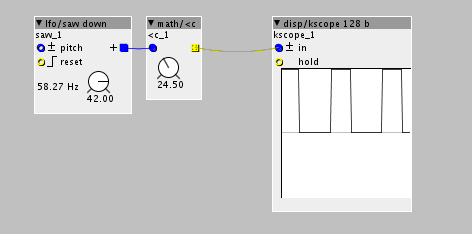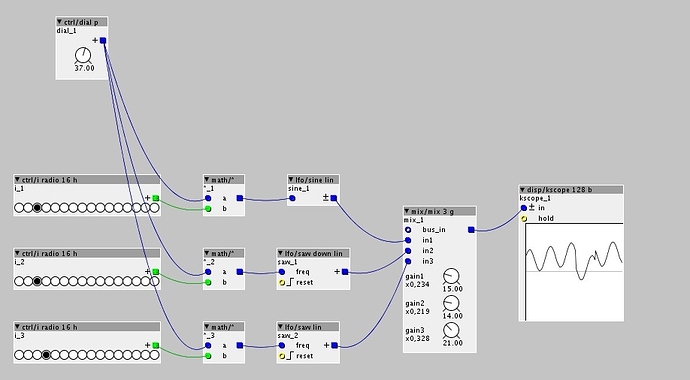Oh and thanks again Blindsmyth. I havent tried the blue mixer on several envelopes yet. looking forward to doing that. Would never of thought of it. and trying your wah ideas too.
How do I fix a ratio between several tremolos?
I'm not even 100% sure the Axoloti has what I'm talking about amongst its stock objects as I can't check right now (because I'm at work, ahem). A comparator is how PWM is done in the analogue domain, it outputs a high if one input is higher than the other and a low if they're the other way around. By comparing a saw or triangle to a fixed reference, you can create a pulse wave that is proportional to the ratio of how much of the waveform falls above or below the reference. Then you can vary the reference to change the pulse width. Hope that makes sense. Anyway, I'm going to have to try it when I get home because I want to see if it can be done with the stock objects.
Of course! I was thinking in analogue terms too much, it seems obvious that it would be there as < and >.
Thanks for this idea, Sir P and Technobear. will try that too. looks a good one. Would I still use an env obj? or can that yellow go stright into VCO blue in?
Also noted, I should start using scopes and meters more to see what is going on.
richard
I assume you meant VCA? For a choppy type of tremolo you'd want the yellow signal straight into the VCA. Yeah, yellow outputs can be connected to blue inputs and they get automatically converted. 0 on a yellow signal becomes 0 on a blue signal and 1 becomes 64.00. You could connect the yellow signal through a k-rate lowpass filter and then onto the VCA, this would give you a smoothness control that lets you soften the effect slightly if you desire. Some guitar tremolo pedals have exactly this control (sometimes called 'shape' or something similar).
No problem 
This is a great thing to know thx! But If you want to set ratios like 3/2 (Triplets) wich would aproximately be setting the lfo 7 Semitones higher 7 (perfect fifth) you will have the Lfo's drifting because in our tempered system the musical invervalls are not based on these simple mathematical ratios.
So I think hooking up controlls to the blue inlets of Lfos and multiplying them with whole numbers of math/*c might be better I guess.
This is a cool thing I didn't know either, nice.
That's true, but don't forget that you have two decimal places of precision too, so you can get cents. 7.02 is really really close to a true perfect 5th, but I think there would still be a tiny bit of drift due to rounding to only two decimal places.
I'm not sure I follow the bit about multiplying a control signal by whole numbers, can you give an example?
I just had an idea to avoid the drift: hardsync!
You'd need three LFOs for a 3/2 ratio, one square wave master and two slaves of whatever waveform you want (as long as it has a reset input). The master is connected to the reset input of the two slaves, you then have one slave set 12 units faster than the master and another set 19.02 faster. This gives you a nice 1:2:3 ratio, which might drift very slowly, but it's being synchronised every beat of the master.
 I have tried the lfo/sawdown then math [larger than]c with the k lowpass filter and I like it a lot ( and yes I want the dial). Thanks Technobear and Sir P - lots of uses for this.
I have tried the lfo/sawdown then math [larger than]c with the k lowpass filter and I like it a lot ( and yes I want the dial). Thanks Technobear and Sir P - lots of uses for this.
Back to my original question. I still think I'd like to be able to fix a ratio triggering the logic counters. The reason is that even if you blocked out a whole row of boxes in the sel16 the env clicks on and off 16 times and this makes a real qualitive difference to the sound. percussive and ratchety (- which is nice to know if thats whats you are after). There is not a way to hold the trigger open for the duration? ( im probably using the wrong terms here). Obviously if I just wanted one i'd run it 16 times slower but id like several at different ratios. Would this need some kind of new object? would a hold option on the sel be good? or a multiple lfo output object with a master speed control? both out of my league but im interested in the discussion. Is my desire to have something like this a bit too singular?
I have really benefitted from all the discussion so far. Thanks again.
You mean so that several consecutive beats in the sel16 just hold the envelope open instead of re-triggering on each? Try using an AHD envelope instead of an AD.
Hi ah I don't know if I choose the right words here  I remember it from a patch I made with recording audio into tables and having it played back by several tables at different speeds. I did this by multiplying the the frequency of lfos that drive the tables before the blue inlet. I wanted to have only different octaves, but I remember also getting intervalls of the harmonic scale multiplying with math *c, wich would be what you need in order to get clean triplets and dotted notes. (or even more experimental polyrhytmhs like quintuplets etc)
I remember it from a patch I made with recording audio into tables and having it played back by several tables at different speeds. I did this by multiplying the the frequency of lfos that drive the tables before the blue inlet. I wanted to have only different octaves, but I remember also getting intervalls of the harmonic scale multiplying with math *c, wich would be what you need in order to get clean triplets and dotted notes. (or even more experimental polyrhytmhs like quintuplets etc)
Unfortunately (or rather fortunately  ) I don't have time this weekend, playing two gigs, but I can look this up next week, I guess it could be a solution what @Zedkah looks for.
) I don't have time this weekend, playing two gigs, but I can look this up next week, I guess it could be a solution what @Zedkah looks for.
Ah, I've just been looking at the LFOs and there are ones with linear frequency input. These would allow what you're talking about, you could multiply the frequency signal by an integer and it'd give you an 'overtone' of the base frequency. This is why linear frequency control can be useful, you can define intervals with multiplication or division. Exponential control only requires addition or subtraction to define an interval, but when you're working with 12et it can be hard to get the precision needed for true harmonic intervals.
OK, I will try that. But the hold value is a time so that would need to be re adjusted for faster masters lfo speeds. it would simply hold open over a white square if set too long- or would it? I will try it .
thanks,
richard
No, the AHD doesn't have a hold time, but rather stays open for as long as the gate signal is high.
You're right to be confused though, IMO it's misnamed, it's what would normally be called an AR envelope.
The name AHD implies three stages with three controls, with the hold time being an adjustable wait before the decay begins. But the (misnamed) AHD object rises at the attack rate when the gate goes high and stays there until the gate goes low and then drops at the 'decay' rate (which is really a release time since it comes after the gate goes low).
Thanks again Sir.
Yes, I realise that i was confusing hold with the sustain of an ADSR. I havent had enough time to try AHD envelopes properly yet but good to have something else to try.
still tinkering with this. I would still like sin and a Triangle LFO's that could put out several fixed ratio versios of itself. say x2,x3,x4,x5 x6 times faster than the parent freq.
just use different linear lfo's with the same ctrl source multiplied with different values with a math * object
here I've used radio buttons to get the different values to be multiplied with the ctrl line
MIDI controlled Stutter Effect
That's the way 
Just be carefull to use the lin lfo with freq input, otherwise the ratios won't be right, as discussed above.
Thanks for this...looks good. So the radio 16 control provides the number the dial control is divided by?


